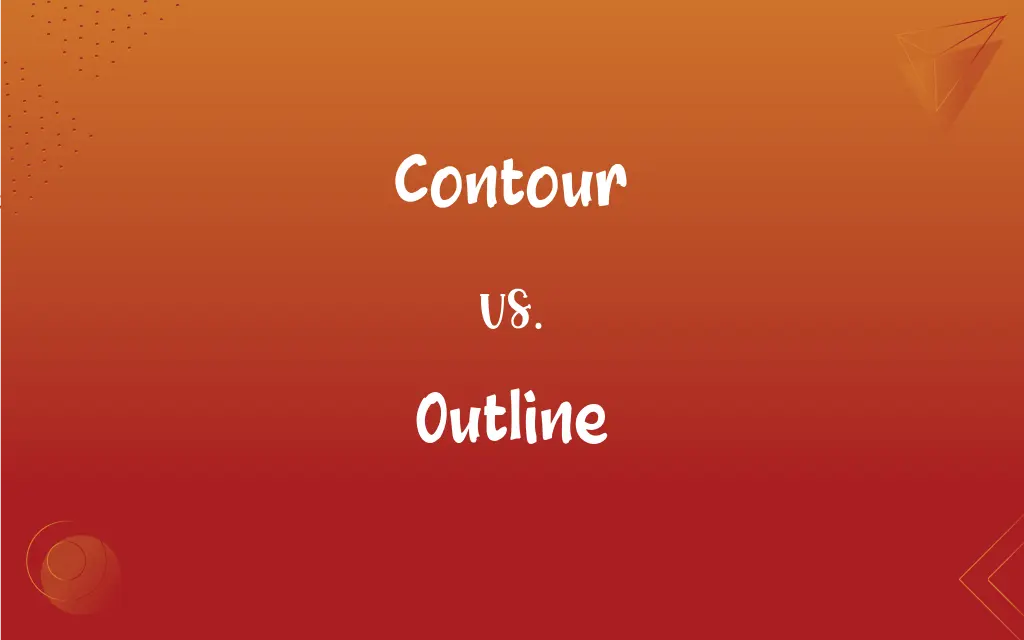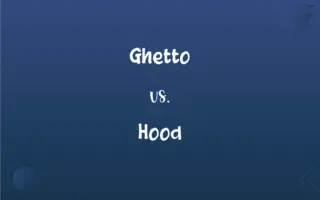Contour vs. Outline: What's the Difference?
By Janet White & Harlon Moss || Updated on March 3, 2024
Contour maps shapes and depth, while Outline defines edges and boundaries.

Key Differences
Contour refers to the shape and structure of a physical form or surface, often emphasizing the curves, elevations, and depressions that define an object's three-dimensional aspect. In art and design, contours provide a visual guide to an object's volume and how it occupies space, often used to suggest depth and form in a two-dimensional representation. Outline, on the other hand, denotes the outermost lines or edges that define the shape of an object, without implying depth or volume. Outlines are used to demarcate the boundary of shapes and are foundational in sketching and preliminary drawings, serving as a guide for further detailing or coloring.
Contour lines in mapping and topography represent elevation and terrain on a flat surface, where each line connects points of equal elevation, helping to visualize the landscape's form. These lines allow the viewer to understand the terrain's inclinations, peaks, valleys, and flat areas, providing a semi-three-dimensional perspective. Outlines are crucial in graphic design, illustrations, and technical drawings to establish basic shapes and frameworks. They create clear distinctions between different elements in a composition, allowing for easier interpretation and further development of the artwork or design.
In contour drawing, the focus is on capturing the essence of the subject's form through continuous lines, without lifting the drawing instrument from the paper. This technique emphasizes the flow and curvature of the subject, encouraging a more holistic view rather than concentrating on details. Outlines, by contrast, can be the starting point for detailed work, where the initial boundary lines serve as a constraint within which colors, textures, and finer details are added. Outlines can be both functional, as in technical blueprints, or artistic, serving as the structure for intricate designs or illustrations.
The perception of depth and volume achieved through contouring is especially important in fields like art, where the illusion of three-dimensionality on a flat surface can be achieved through varying line weights, shading, and perspective techniques.
Outlining, while simpler in concept, is foundational in both art and design, as it establishes the primary framework for more complex compositions. It's a critical step in the creative process, allowing for strategic planning and layout before advancing to more detailed or nuanced work.
ADVERTISEMENT
Comparison Chart
Definition
Represents shape and depth
Defines edges and boundaries
Use in Art
Suggests volume and form
Establishes basic shape
Use in Mapping
Shows elevation and terrain
Demarcates object boundaries
Technique
Continuous lines without lifting
Clear, defining boundary lines
Focus
Depth and three-dimensionality
Shape and limits
ADVERTISEMENT
Perception
Illusion of 3D on flat surfaces
Clear distinction of forms
Importance in Design
Adds realism and depth
Provides structure and framework
Variability
Lines vary by elevation change
Consistent to define edges
Contour and Outline Definitions
Contour
The general form or structure of something.
The car's sleek contour made it very aerodynamic.
Outline
A line or set of lines enclosing or indicating the shape of an object in a sketch or diagram.
He drew a quick outline of the house before adding details.
Contour
A line on a map joining points of equal height above or below sea level.
The contour lines on the map showed the mountain's steepness.
Outline
To draw or trace the outer edge of something.
She outlined the drawing before filling it with color.
Contour
A way to use makeup to define the shape and features of the face.
She used contouring to highlight her cheekbones.
Outline
The outermost shape of an object or figure.
The outline of the tree was visible against the sky at dusk.
Contour
The outline of a figure, body, or mass.
Outline
A boundary or contour of a subject or object.
The outline of the city was dominated by skyscrapers.
Contour
A line that represents such an outline.
Outline
A general description or plan showing the essential features of something but not the detail.
The project outline was due before the detailed proposal.
Contour
A contour line.
Outline
A line indicating the outer contours or boundaries of an object or figure
Could see the outlines of an animal in the dark.
Contour
A varying characteristic or quality of something, such as a melody.
Outline
A style of drawing in which objects are delineated in contours without shading.
Contour
(Linguistics) The distinctive rising and falling patterns of pitch, tone, or stress.
Outline
A sketch done in this style.
Contour
To make or shape the outline of; represent in contour.
Outline
A summary of a text or subject, usually presented in headings and subheadings.
Contour
To build (a road, for example) to follow the contour of the land.
Contour
Following the contour lines of uneven terrain to limit erosion of topsoil
Contour plowing.
Contour
Shaped to fit the outline or form of something
A contour sheet.
Contour
An outline, boundary or border, usually of curved shape.
The low drag contour of a modern automobile
Contour
A line on a map or chart delineating those points which have the same altitude or other plotted quantity: a contour line or isopleth. Category:en:Curves
Contour
(linguistics) a speech sound which behaves as a single segment, but which makes an internal transition from one quality, place, or manner to another.
Contour
(figurative) A general description giving the most important points.
Contour
(transitive) To form a more or less curved boundary or border upon.
Contour
(transitive) To mark with contour lines.
Contour
(intransitive) To practise the makeup technique of contouring.
Contour
The outline of a figure or body, or the line or lines representing such an outline; the line that bounds; periphery.
Titian's coloring and contours.
Contour
The outline of a horizontal section of the ground, or of works of fortification.
Contour
A line drawn on a map connecting points of equal height
Contour
Any spatial attributes (especially as defined by outline);
He could barely make out their shapes through the smoke
Contour
A feature (or the order or arrangement of features) of anything having a complex structure;
The contours of the melody
It defines a major contour of this administration
Contour
Form the contours of
Contour
The outline representing or bounding the shape or form of something.
The artist captured the model's contours perfectly.
Contour
Shape or form of the outer edges or surface.
The contour of the landscape was changed by the new building.
FAQs
Can contour lines indicate elevation on a map?
Yes, contour lines connect points of equal elevation, indicating terrain and elevation on maps.
What is the main difference between contour and outline?
Contour emphasizes the volume and depth of an object, while outline focuses on its boundary and shape.
Can outlines be used in conceptual work?
Yes, outlines are often used in planning and conceptual stages to define the essential shape and limits of designs or ideas.
Is outlining necessary for every drawing?
Not always, but it's a common practice to establish the basic shape before adding details or colors.
Do contour drawings have to be detailed?
Contour drawings focus more on capturing the essence of form and may not include detailed features.
How do contours contribute to the perception of depth in art?
Contours mimic the way light and shadow play on surfaces, suggesting depth and form even on flat surfaces.
Is one technique superior to the other?
No, both contouring and outlining serve different purposes and are chosen based on the desired outcome of the artwork or design.
How do artists use contours in drawing?
Artists use contours to depict the form and detail of a subject, often employing varying line weights and styles to convey depth, texture, and perspective.
Are outlines always visible in the final artwork?
Not necessarily; outlines can be guides that are later obscured by paint, ink, or other mediums.
How do artists decide between using contour or outline?
The choice depends on the artist's intent, style, and the subject's nature, considering what they aim to emphasize.
Can both contour and outline be used in the same piece?
Yes, artists often combine both techniques to add complexity and depth to their work.
Are outlines used in technical drawings?
Yes, outlines are crucial in technical drawings to define the boundaries of objects, parts, and sections, providing clarity and precision.
How do outlines contribute to graphic design?
In graphic design, outlines can simplify complex images into recognizable shapes, making designs more accessible and understandable at a glance.
How do contours enhance the realism of an artwork?
By accurately depicting the curves and variations of a surface, contours can add realism and depth to artwork, making subjects appear more three-dimensional.
Do contour maps have any practical applications?
Contour maps are widely used in geography, geology, and civil engineering to represent the topography of the Earth's surface, aiding in land use planning, navigation, and construction.
Can the use of outlines simplify an image?
Outlines can simplify an image by reducing it to its essential shape, making it easier to identify and understand, especially in minimalistic designs.
Is it possible for an object to have both contours and outlines?
Yes, an object can be represented with both contours to show its three-dimensional form and outlines to define its external boundary.
Can contours indicate depth and dimension?
Yes, contours can suggest depth and dimension by depicting the varying elevations and depressions of a surface, often used in maps and art to convey three-dimensionality.
Is an outline always a closed shape?
Typically, an outline is a closed loop that defines the outer edge of an object or figure, distinguishing its overall shape from its surroundings.
Can contour lines be used in 3D modeling?
Contour lines are often used in 3D modeling to represent the topography of a landscape or to define the curvature and form of objects.
About Author
Written by
Janet WhiteJanet White has been an esteemed writer and blogger for Difference Wiki. Holding a Master's degree in Science and Medical Journalism from the prestigious Boston University, she has consistently demonstrated her expertise and passion for her field. When she's not immersed in her work, Janet relishes her time exercising, delving into a good book, and cherishing moments with friends and family.
Co-written by
Harlon MossHarlon is a seasoned quality moderator and accomplished content writer for Difference Wiki. An alumnus of the prestigious University of California, he earned his degree in Computer Science. Leveraging his academic background, Harlon brings a meticulous and informed perspective to his work, ensuring content accuracy and excellence.































































